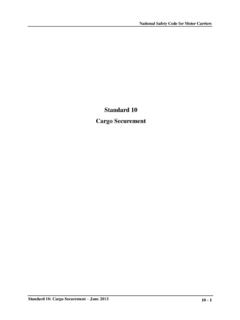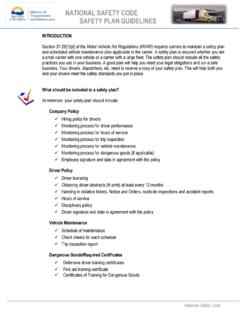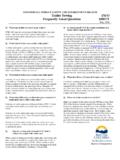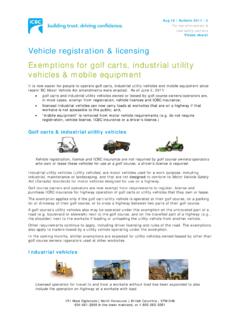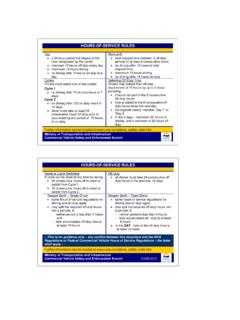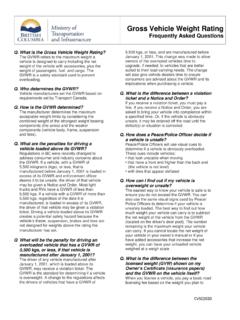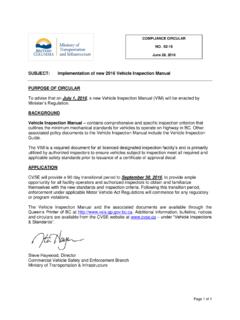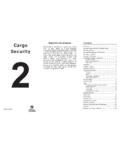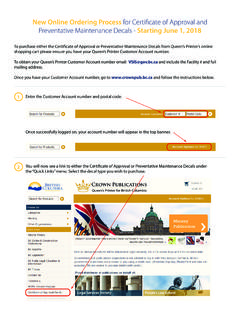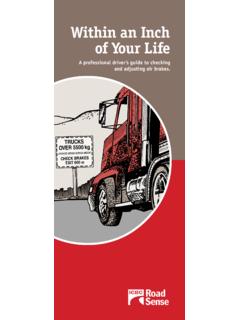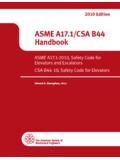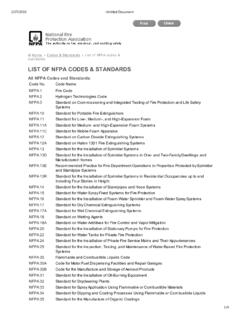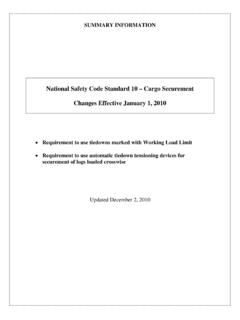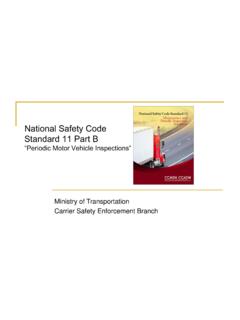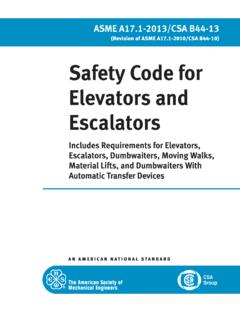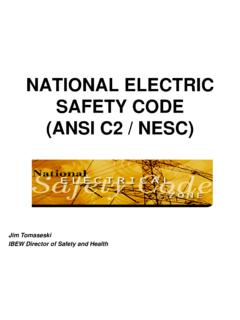Transcription of National Safety Code Standard 10, Cargo Securement ...
1 National Safety CODES tandard 10 Cargo SecurementGuidance: Securement ofDressed Lumber and Similar building Materialson Flatbed Trucks and TrailersOctober 20, 2005 DisclaimerThe guidance that is provided in this document is offered for convenience only. For accuratereference, please consult the National Safety code Standard 10 ( ) and theapplicable provincial and territorial regulations.*Minimum Strength of Securement System (DIVISION 3, Section 10) The aggregate working load limit of the Cargo Securement system used to secure anarticle or group of articles of Cargo on or within a vehicle shall be not less than 50% ofthe weight of the article or total weight of the group.
2 Aggregate working load limit is the sum of One-half of the working load limit for eachend section of a tiedown that is attached to an anchor (1) ApplicationThis division applies to the transportation of bundles of dressed lumber and packagedlumber, and unitized building products, including plywood, gypsum board or othermaterials of similar by SideWhere bundles are placed side by side each bundle shall be in direct contact with eachother, or a method shall be used that prevents the bundles from moving towards eachother. CORRECT INCORRECT46(1) Bundles placed directly on top of other bundlesBundles carried in 2 or more layers placed directly on top of other bundles, or on spacersof adequate size and orientation, shall be secured by Tiedowns over the top layer of bundles, in accordance with provisions of section 22of this Standard , with a minimum of two tiedowns for bundle(s) longer than m(5 ), and Tiedowns over the second layer of bundles, or at (6 ) above the vehicle deck,whichever is greater, or not over m (6 )
3 Above the deck for other multiple layersin accordance with the provisions of section 22 of this Standard , for each stack ofbundles composed of more than two layer3 MINIMUM NUMBER OF TIEDOWNS REQUIRED FOR BUNDLES OF DRESSED LUMBER AND UNITIZED BUILDINGPRODUCTS (SECTION 46)Article Blocked/Immobilized*Article Not Blocked/ImmobilizedARTICLEDESCRIPTIONL ayersin StackTop Layer(# Tiedownsrequired) Middle Layers(# Tiedowns required)Top Layer(# Tiedownsrequired) Middle Layers(# Tiedowns required)2 layers1 Not required1 Not required3 layers11 over second layer11 over second (5ft) or shorterand 500kg (1100lb) orlighterMore than3 layers11 over middle layer at point not higherthan (6 ) above deck11 over middle layer at point not higherthan (6 ) above deck2 layers1 Not required2 Not required3 layers11 over second layer22 over second (5 ft) or shorterand over 500kg (1100lb)More than3 layers11 over middle layer at point not higherthan (6 ) above deck22 over middle layer at point not higherthan (6 )
4 Above deck2 layers2 Not required2 Not required3 layers21 over second layer22 over second layerMore than (5 ft)but (10 ft) or lessMore than3 layers21 over middle layer at point not higherthan (6 ) above deck22 over middle layer at point not higherthan (6 ) above deck2 layers 2 tiedowns for first (10 ) of Cargo , plus 1 tiedown for every (10 ) or part thereofNot required 2 tiedowns for first (10 ) of Cargo , plus 1 tiedown for every (10 ) or part thereofNot required3 layers 2 tiedowns for first (10 ) of Cargo , plus 1 tiedown for every (10 ) or part thereofTiedowns over second layer: 1 for first (10 ) of Cargo , plus 1 tiedown for every (10 ) orpart thereof 2 tiedowns for first (10 ) of Cargo , plus 1 tiedown for every (10 ) or part thereofTiedowns over second layer.
5 2 for first (10 ) of Cargo , plus 1 tiedown for every (10 ) orpart thereofLonger than (10ft)More than3 layers 2 tiedowns for first (10 ) of Cargo , plus 1 tiedown for every (10 ) or part thereofTiedowns over middle layer at point nothigher than (6 ) above deck: 1 for first (10 ) of Cargo , plus 1 tiedown for every (10 ) or partthereof 2 tiedowns for first (10 ) of Cargo , plus 1 tiedown for every (10 ) or part thereofTiedowns over middle layer at pointnot higher than (6 ) above deck: 2 for first (10 ) of Cargo , plus 1 tiedown for every (10 ) orpart thereof*Articles of Cargo must be blocked or immobilized by a front-end structure, bulkhead or other immobilized Cargo to prevent it from moving : Additional tiedowns may be required to ensure the aggregate working load limit is at least 50% of the weight of the Cargo the tiedowns are Illustrations Three layers high.
6 First lift not butted or immobilized against vehicle structure, require atleast 2 belly wrap tiedowns. Second, third and fourth lifts are butted or immobilizedagainst other bundles, therefore a minimum of 1 belly wrap tiedown required for thesecond, third and fourth lifts. Minimum 2 tiedowns over bundles on top layer. Three layers high. First lift not butted or immobilized against vehicle structure, require atleast 3 belly wrap tiedowns and a minimum of 3 tiedowns over top layer. Second lift isbutted or immobilized against other bundles therefore 1 tiedown may be reduced on bellywrapped layers and top layer(s) of second lift.
7 Only two layers high, therefore does not require belly wrap tiedowns. Must meet the 50%aggregate WLL for tiedowns over top More than three layers high, belly wraps are required over the second or third layers, notmore than (6 ) from the deck. Three layers high, four lifts not butted or immobilized against forward movementtherefore requires a minimum of two belly wrap tiedowns over second layers and aminimum of 2 tiedowns over top layers for each group or lift due to length of Trailer equipped with bulkhead. Three layers high, first lift butted or immobilized againstvehicle structure and each additional lift is also butted or immobilized against otherbundles.
8 Minimum 2 tiedowns on top layers. Second layers require a minimum of 1 bellywrap tiedown due to length of Trailer equipped with bulkhead. Three layers high, first lift butted or immobilized againstvehicle structure and each additional lift is also butted or immobilized against otherbundles. Minimum 2 tiedowns required over top layers due to length of bundles. Secondlayers require a minimum of 2 belly wrap tiedowns for the front and rear lifts andminimum a minimum of 1 belly wrap tiedown for the middle lift, due to length of bundle.
9 Three layers high, three lifts not butted or immobilized against forward movement,require a minimum of 3 belly wrap tiedowns and a minimum of 3 tiedowns over toplayers for each group or lift(s) due to length of bundle. Fifth layer on first lift not butted or immobilized against vehicle structure, therefore atleast 3 tiedowns are required due to length of bundle. A minimum of 2 belly wrap tiedowns are required over third layer on each lift (at (6 ) from deck), as they are immobilized against forward movement.
